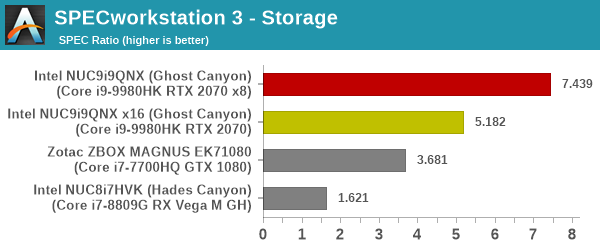Intel Ghost Canyon NUC9i9QNX Review: NUC 9 Extreme Realizes the SFF Dream
by Ganesh T S on April 16, 2020 8:05 AM ESTMiscellaneous Aspects: Storage Performance
The preceding sections analyzed the performance of two Intel NUC9i9QNX configurations for a variety of workloads, ranging from office usage to professional and industrial workstation applications. We also looked at gaming performance and the suitability of the PC for home-theater use. One of the aspects that we touched on and off across all sections was the evaluation of the storage subsystem. A little bit of additional analysis is in order. In particular, we operated the Intel SSD 905p Optane drive in two modes - directly attached to the CPU's PCIe lanes, and attachment through the PCH.
| Intel NUC9i9QNX Storage-Specific Benchmarks |

Directly attaching the Optane drive to the CPU's PCIe lanes yields 40%+ benefit for workstations based on SPECworkstation 3's wpcStorage workload. PCMark 10's storage bench shows a 50%+ increase in storage bandwidth and a 35%+ decrease in average access time for consumer workloads. The storage bandwidth for the secondary drive attached to the PCH also suffers when the primary drive contends with it for access to the CPU through the DMI link, as shown in the PCMark 10 storage bandwidth graph for the secondary drive above.
On the networking side, we are yet to set up our 802.11 ax / Wi-Fi 6 testbed for small form-factor PCs, and hence, there are no bandwidth numbers to report yet. However, it must be noted that the NUC 9 Extreme Kits, like the Frost Canyon NUC we recently reviewed, come with 802.11ax / Wi-Fi 6 support, and its theoretical maximum bandwidth of 2400 Mbps betters the 867 Mbps offered by the Wireless-AC 8265 in the Hades Canyon NUC and the 1733 Mbps offered by the Wireless-AC 9560 in the Bean Canyon NUC. The AX200 WLAN component takes advantage of the MAC built into the CM246 chipset, but uses a dedicated PCIe x1 link to interface (unlike the AX201 / CNVi combination in the Frost Canyon NUC). The AX200 has a 2x2 simultaneous dual-operation in 2.4 GHz and 5 GHz bands and also comes with support for 160 MHz-wide channels.










109 Comments
View All Comments
timecop1818 - Thursday, April 16, 2020 - link
Really bad selection of pictures. Did you not actually have a unit with you when reviewing? There's no external shots, there's no pics of the board/GPU connected together, there's no pics of rear backplane with ports/whatever, basically no useful info. I clicked through the gallery and I have no idea how big this thing is, or how the GPU fits into the picture, or anything else. Even "setup notes" page shows nothing useful.DanNeely - Thursday, April 16, 2020 - link
The chassis gallery on the 1st page shows the fully assembled system with the rear IO ports visible and gives a decent visual idea of how big the system is.timecop1818 - Thursday, April 16, 2020 - link
Oh hey, I see the stuff now. There's separate galleries throughout the article, for some reason I thought there was only one per page, and the 1st page only showed disassembled cpu module so I thought that was it. Thanks for pointing it out.FireSnake - Thursday, April 16, 2020 - link
Based on this:https://www.notebookcheck.net/AnandTech-editor-rep...
they are not getting any money from me!
For a loooong looong time (those includd too).
bug77 - Thursday, April 16, 2020 - link
It's a good thing you don't get hung up on details like proof and stuff. Guilty until proven innocent, eh? (And yes, I know history doesn't work in their favor.)DigitalFreak - Thursday, April 16, 2020 - link
Ian doesn't seem like the person to throw around baseless accusations.ganeshts - Thursday, April 16, 2020 - link
The tweet has been misinterpreted and now taken a completely unintended shape of its own. Ian plans to clarify the usage of the word 'incentive' in the context in an upcoming video / post.FWIW, if anyone believe AMD doesn't offer incentives to its partners (of a type similar to what Intel does, and what is completely legal), then the person has no idea of how the technology industry / silicon vendors operate.
If anyone thinks the reason for lack of high-performance AMD-based (read, Renoir) 'NUC's is Intel, then I have a bridge to sell. No one is preventing AMD from creating a reference design for a Renoir-based 4x4 board or innovate with Compute Element-like products. OEMs can take the plunge only if the silicon vendors offer them a proof of concept. If a Renoir NUC reference design exists, but OEMs still don't pick it up to offer them in the market, that would be worthy of deeper investigation (that could still throw up legitimate reasons).
Namisecond - Friday, April 17, 2020 - link
Even when reference designs exist, availability of parts can come into play, or even OEM disinterest.quadrivial - Friday, April 17, 2020 - link
AMD has reference designs and an entire set of embedded Zen 1 chips made explicitly for that purpose. Udoo Bolt was kickstarted by a fairly small company. If they could do it, why not bigger companies?arashi - Saturday, April 18, 2020 - link
You must understand that Intel PR and legal has been in touch.